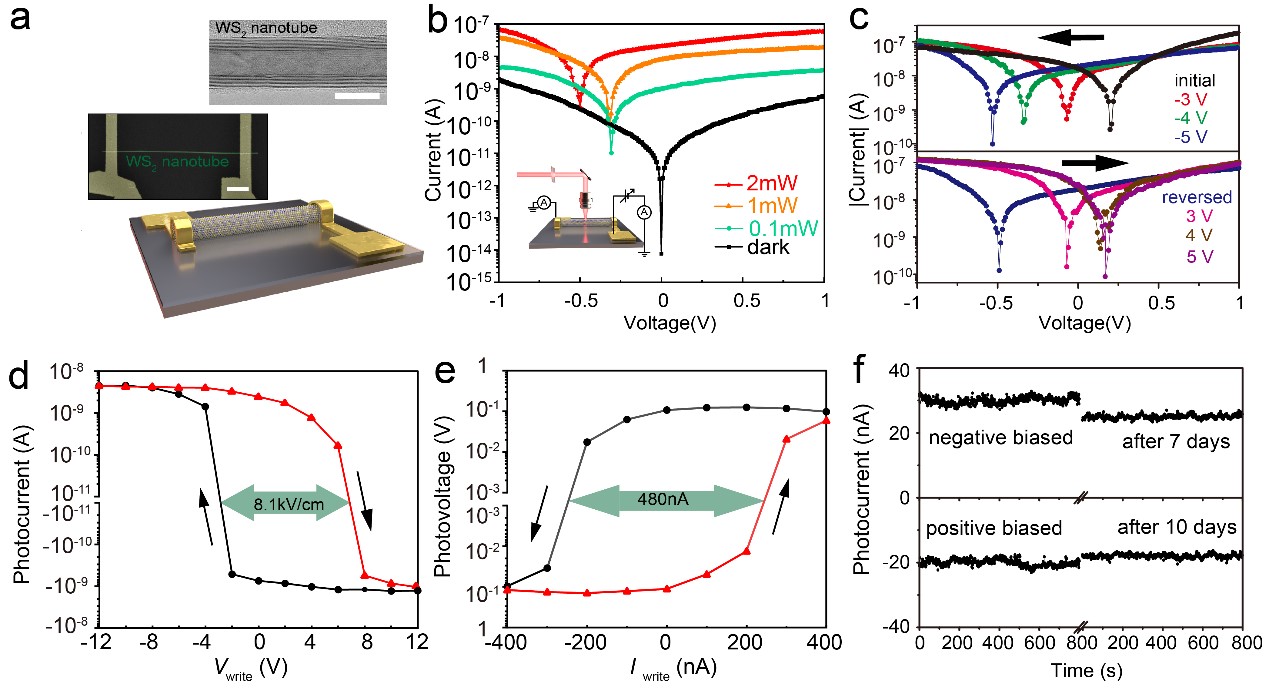Progress in the research of the mesoscopic slip ferroelectric effect and its application in intelligent hardware systems
来源: 作者: 发布时间:2022-10-10Recently, Guo Yao's research group from the Beijing Institute of Technology proposed a new type of slip ferroelectric effect at the mesoscopic scale. Based on this effect, a new type of photovoltaic random-access memory was developed, which can simultaneously realize sensing and storage in the visible light range, and can further build a "sensing-computing-storage-driving" function integrated artificial vision system at the hardware level. The research results were recently published in Nature Communications (https://www.nature.com/articles/s41467-022-33118-x) and featured by the editor in the section “device”.
The ferroelectric effect is an important physical phenomenon discovered a hundred years ago by Joseph Valasek. Ferroelectric materials have important applications in electronic devices and energy conversion. The traditional ferroelectric effect is essentially produced by atomic lattices with bistable structures. Recently, Guo Yao's research group from the Beijing Institute of Technology proposed a new type of ferroelectric effect based on piezoelectricity and super lubrication. This new type of ferroelectric effect does not depend on the bistable system of the atomic lattice, but is generated by the piezoelectric effect and reverse piezoelectric effect, mechanical sliding, and electrical polarization. The experimental results of in situ characterization combined with computer simulations indicate that the interlayer superlubricity and lattice asymmetry in the van der Waals layered material lead to the piezoelectric effect as the two key factors constituting the novel ferroelectric effect. The researchers call this ferroelectric effect caused by the interlayer van der Waals superlubricity and piezoelectric effect at the mesoscopic scale as the mesoscopic in-plane sliding ferroelectricity. This novel ferroelectric effect provides a new idea for the construction of controllable spontaneous electric polarization of material systems.

Figure 1 WS2 nanowire PV-RAM device (a) device schematic diagram (b) photovoltaic response of the device (c) programmability of photovoltaic response,
(df) ferroelectric hysteresis and storage of photovoltaic response
Based on this novel ferroelectric effect, researchers have WS2 nanotube’s polarization tuned by external voltage/current. With the appropriate forbidden bandgap, the WS2 nanotubes generate ferroelectric hysteresis of photovoltaic response in the visible light range (as shown in Fig. 1). The mesoscopic slip ferroelectric effect of WS2 nanotubes makes its photovoltaic response programmable and non-volatile photovoltaic characteristics, so it is a natural and ideal photovoltaic random-access memory (photovoltaic random-access memory, PV-RAM). The research team further took advantage of this feature to prepare a 16-pixel PV-RAM array, and used the photoresponsivity (i.e., the ratio of output photocurrent to input optical power) of each PV-RAM structural unit in the array as a synapse in the neural network. The weight is adjusted by external voltage/current excitation, which realizes the embedding of the neural network algorithm at the hardware level, and successfully demonstrates the image recognition function with the supervised learning and reinforcement learning algorithms (as shown in Figure 2). This is the first time that the four functions of sensing, computing, storage, and driving have been integrated into a hardware system based on smart materials, which has important reference significance for building future high-speed, low-power, and even self-driven intelligent IoT platforms.

Fig. 2 Demonstration model of artificial vision system embedded in PV-RAM array (a) PV-RAM array; (b) Learning accuracy curves under different levels of background noise; (c) Demonstration of artificial vision system to recognize "Z", "I", "O", "N" English letters (here is a tribute to the movie Matrix, Zion is the last base of human beings who resisted artificial intelligence, and it is also a symbol of land in the Hebrew Bible), (df) Reinforcement learning process
Sun Yan and Xu Shuting, graduate students of Beijing Institute, and undergraduate student Xu Zheqi, are the co-first authors of the article. Associate Professor Alla Zak of Holon Institute of Technology, Israel, and Associate Researcher Guo Yao of Beijing Institute of Technology are the corresponding authors of the paper. Cooperative institutions include Israel's Weizmann Institute of Science, Peking University, Beijing Graphene Research Institute, and Israel's Holon Institute of Technology.




